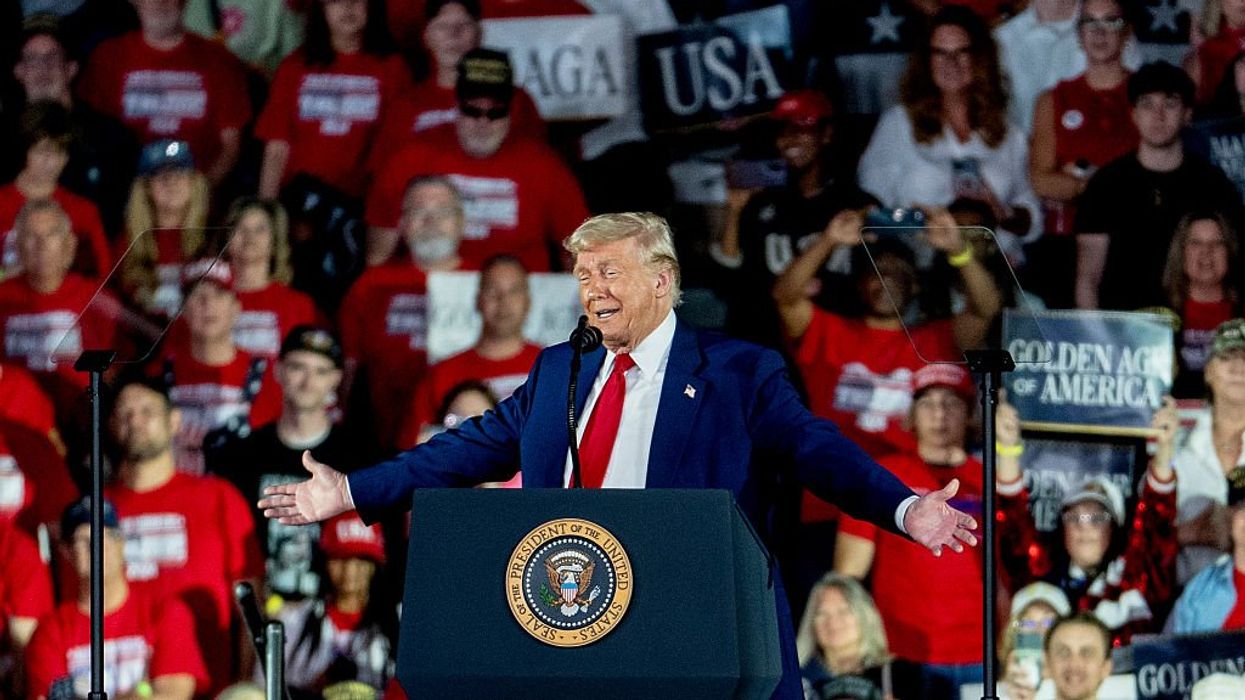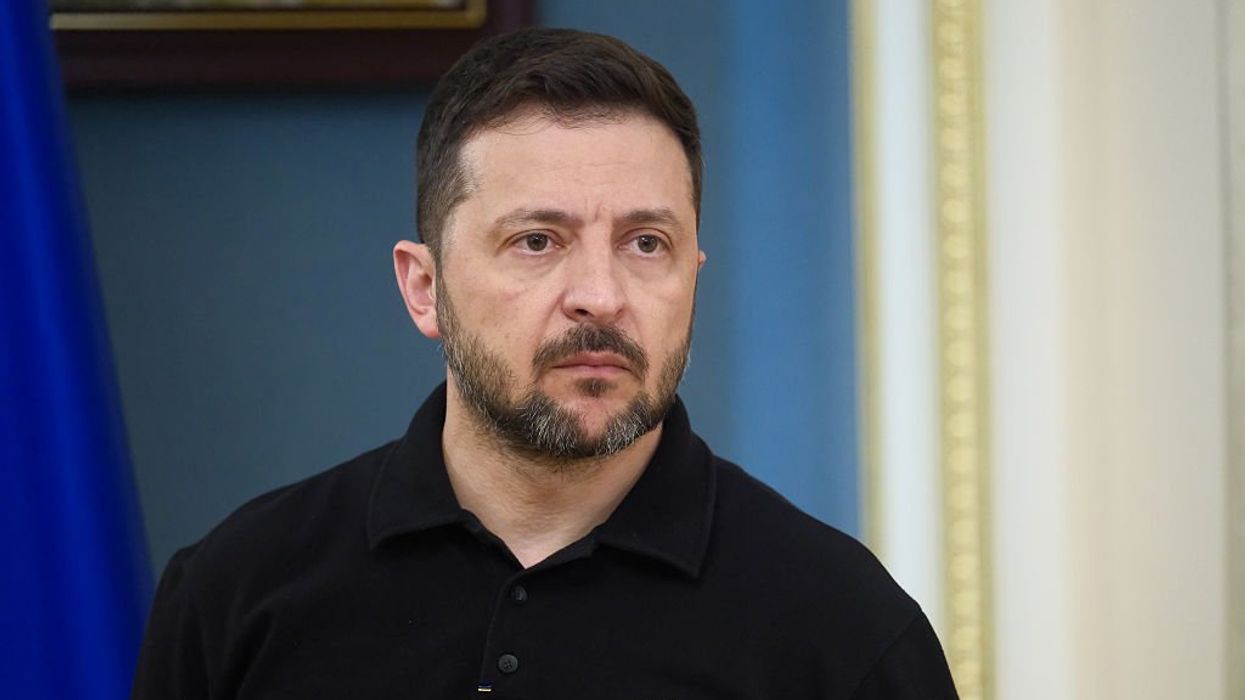Last August, the infamous anti-woke guerilla street artist known as Sabo displayed several shocking posters at the American Airlines Center in Dallas, Texas, criticizing American Airlines’ controversial woke policies. Glenn has become a fan of Sabo's work, applauding him for his edgy, yet strikingly powerful art, which conveys important messages that not everyone is brave enough to convey in public.
This week, Sabo is BACK, and this time, he hit the streets of Los Angeles, taking aim at Joe Biden, Gavin Newsom, BLM, and more. He gave glennbeck.com exclusive access to his latest installation, which leaves NO ONE from the establishment unscathed.
You can find Sabo's entire collection HERE. In the meantime, here are five of our favorite pieces from Sabo's latest anti-woke art campaign:
"STOP!"

Courtesy of Sabo
A prominent theme in Sabo's work is keeping the establishment accountable by laying their hypocrisy bare for all to see. Sabo's brilliance lies in the fact that he never puts words in the establishment's mouth. He lets their words, actions, and hypocrisy speak for themselves.
This theme is perfectly exemplified in this particular stop sign piece in which Sabo captures one of the more infamous moments when Joe Biden displayed questionable behavior towards minors. Sabo remarked how he had wanted to do a stop sign piece for years because they are, in his words, "so in your face." The perfect opportunity arose when he came across the viral clip of Joe Biden sniffing the hair of the young girl depicted in the poster. He said:
When I saw that particular picture of that girl pulling away from Biden, she was just screaming, 'STOP!' And I knew it was perfect [for the piece].
The media has worked diligently to cover up Biden's questionable behavior with minors. But Sabo isn't giving him a free pass, and he doesn't need to insert his own opinions to do so. He lets Biden's behavior speak for itself.
"Exodus East"

Courtesy of Sabo
The theme of letting the establishment's actions speak for themselves permeates Sabo's "Totem" collection consisting of repurposed street signs. Sabo says this collection represents "the collisions our country has suffered throughout the past couple of years." From the COVID pandemic to January 6, Sabo's stark messaging forces the viewer to recall the hypocrisy and corruption latent in the establishment's responses to these landmark events that shook our nation to its core.
In this particular street sign piece, Sabo wanted to commemorate those affected by Newsom's draconian COVID mandates that left thousands jobless, out of business, and destitute while Newsom himself was dining at the French Laundry with the nation's elite:
I wanted to mount [this piece] in Los Angeles because it basically tells a story of this particular time. COVID, Newsom, and I want to commemorate the people who said, 'I love this state, but I have to go.'
Sabo's stark messaging forces the viewer to recall the hypocrisy and corruption latent in the establishment's responses to these landmark events that shook our nation to its core.
The name of the collection, "Totem," came from Sabo's friend who remarked that the pieces reminded him of the Totem poles from Indigenous tribes. Embedded within the Totem poles themselves are the stories of a people, forcing the viewer to recall significant events in their cultural history as it's passed down from generation to generation. Sabo hopes to achieve the same effect through this collection:
In a graphic sort of way, these pieces are like stained-glass art. People would look at them and tell these stories. God willing 100 years from now, if they still stand, people will be reminded of them.
Sabo's work is for the Americans who are fed up and disillusioned with the lack of accountability towards their government. During the pandemic, Americans were censured for going against the mainstream COVID narrative, forced to choose between complying with draconian mandates and putting food on their table, all the while watching their rulers have their cake and eat it too. Two years after the pandemic, the establishment still hasn't been held responsible—and Sabo won't let us forget, despite the ruling class' best efforts.
"Full Mental Jacka**"

Courtesy of Sabo
Remember how the Left called Trump a "warmonger" and warned that he would march us toward World War III? Sabo's take on the Vietnam war-era Full Metal Jacket film poster exposes the irony that it is Biden—not Trump—that has brought us to the precipice of a global War. He said:
The thing that Democrats said Trump would get us into, Biden is getting us into. They failed with Afghanistan. There's a war with Ukraine, and we're getting into a war with Russia. And there's China with Taiwan. Now we're here with Israel and Iran. We are headed towards war.
Sabo remarked on the difficulty of preserving his art. Most of his pieces are vandalized on the street or taken down all together, and those pieces that survive are refused by galleries due to their controversial nature. He said:
I hate that art has become so weak that there probably isn't a gallery in this country that would show these pieces of art.
But Sabo also said the struggle behind his work is implicit within the genre itself, that edgy art with controversial messages is often not accepted in its own time. He said:
I think that's what edgy art is really about. At first, it's not accepted. It's shunned. And later on, people will be able to look at it in a different light, and hopefully, that's how it will be with these pieces.
Ironically, several of these pieces from Sabo's collection have been preserved in a museum, but not for the reasons that you would expect. The Smithsonian acquired multiple of Sabo's pieces in their January 6 installment.
"One Bad Dude: Cornpop"

Courtesy of Sabo
This piece is Sabo's ode to young rappers. Sabo is fascinated with the pro-Trump fervor amongst the new up-and-coming generation of rappers, breaking from their Democrat-dominant predecessors. Sabo says:
Young rappers want Trump because they see what Biden and the Democrats have done to their community.
Sabo once again exposes the irony of the establishment's propaganda. Democrats promised to better the lives of minorities, yet it was Trump who ushered in America's greatest economic era to date, including the lowest unemployment rates for both African Americans and Latino Americans.
Sabo once again exposes the irony of the establishment's propaganda.
Younger generations are experiencing the stark contrast between the Trump-era economic boom and Bidenomics. Sabo said young people "can't afford to eat. They can't afford gas. They can't afford rent," things that they didn't experience under the Trump administration.
The establishment is yet again trying to silence Trump ahead of the 2024 election. Amid an onslaught of indictments and legal suits, Trump has proven one thing: he is a fighter. Nothing exemplifies this more than his mugshot which has become an icon of the resistance against the establishment's onslaught of censorship of those who Trump represents: freedom-loving Americans. Sabo said his rendition of Trump's mugshot was "my way of communicating that he's a bit of a hard thug."
"BLM Loves Hamas Paragliders"
Courtesy of Sabo
Much of Sabo's art has a short shelf life, and not for a lack of relevance or talent. Most of his art pieces are either vandalized or taken down completely within a day of going public. To deter this vandalism, Sabo said he wanted to "come up with a method where people couldn't reach them," and this collection presented the perfect opportunity.
Most of his art pieces are either vandalized or taken down completely within a day of going public.
Sabo created multiple pieces depicting Hamas paragliders, which has become one of the most haunting images to emerge from the October 7th terrorist attacks that killed 1,400 Israeli men, women, and children, the largest attack on the Jewish people since the Holocaust.
This collection calls out BLM's support for the Hamas terrorist, referencing BLM Chicago's tweet in the wake of the attacks that voiced their support for Palestine alongside the same image of the Hamas paragliders. Though they quickly removed the tweet due to backlash, Sabo wouldn't let them get away with it. He said:
I figured the paragliders come from the sky and the air, so it will have the impression of paragliders coming down like they did in Israel. At the same time, I wanted to take a jab at BLM.
Unfortunately, even though the paraglider posters were hung from a telephone wire and streetlights, this didn't deter whoever took them down the next day.











